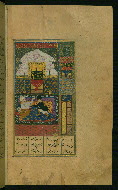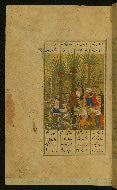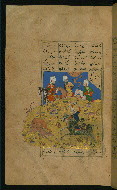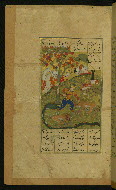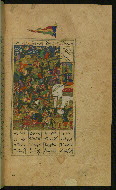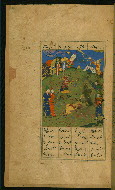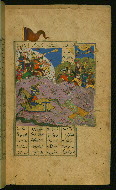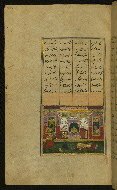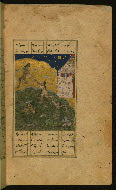Home > Digitized Walters Manuscripts
This document is a tranformation of a TEI P5 XML manuscript description incorporating images. If you have trouble reading special or non-Latin characters on this page, please make sure you have appropriate Unicode fonts installed and an up-to-date web browser.
Walters Ms. W.609, Five poems (quintet)
Browse images (Browse images in a new window) | TEI in XML format
W.609
Five poems (quintet)
Vernacular: خمسه نظامي
Authority name: Niẓāmī Ganjavī, 1140 or 41-1202 or 3
As-written name: Ilyās ibn Yūsuf Niẓāmī Ganjavī
Name, in vernacular: الياس بن يوسف نظامي گنجوي
Note: Author dates preferred by cataloger: d. 605 AH / 1209 CE
This illuminated and illustrated copy of the Khamsah (quintet) of Niẓāmī Ganjavī (d. 605 AH / 1209 CE) was written by Yār Muḥammad al-Haravī in 922 AH / 1516 CE. Written in four columns in black nastaʿlīq script, this manuscript opens with a double-page illuminated frontispiece signed by ʿAbd al-Wahhāb ibn ʿAbd al-Fattāḥ ibn ʿAlī. It contains thirty-five illustrations that were repainted in India during the twelfth century AH / eighteenth CE. The seal of Muḥammad Asharf ibn Muḥammad Khātam al-Ḥusaynī, dated 1173 AH / 1759-60 CE appears on fols. 1a and 401a. It is possible that the brown leather binding with center and side panels brushed with gold is original to the manuscript but was repaired at a later stage in the codex's history.
922 AH / 1516 CE; date given in chronosticon (fol. 401a, above colophon): rāvī khamsah
Present-day Afghanistan (?)
As-written name: ʿAbd al-Wahhāb ibn ʿAbd al-Fattāḥ ibn ʿAlī
Name, in vernacular: عبد الوهاب بن عبد الفتاح بن علي
Note: Name of illuminator appears in double-page illuminated frontispiece
As-written name: Yār Muḥammad al-Haravī
Name, in vernacular: يار محمد الهروي
Book
Literary -- Poetry
The primary language in this manuscript is Persian.
- Transliteration: tammat [sic] al-kitāb al-Khamsah al-mubārak bi-ʿawn Allāh taʿālá wa-tabāraka /1/ ʿalá yad al-ʿabd al-ḍaʿīf al-mudhnib al-rājī ilá raḥmat Allāh /2/ al-ṣamad al-qawī Yār Muḥammad al-Harawī /3/ ghafara Allāh dhunūbahu /4/ m (= tamma) /5/
- Comment: In Arabic; gives the title of the work and the scribe's name
Paper
Buff-colored laid paper
Foliation: ii+401+ii
Catchwords: Written obliquely on versos
17.5 cm wide by 29.0 cm high
9.5 cm wide by 18.5 cm high
- Columns: 4
- Ruled lines: 19
- Framing lines in blue, gold, and black
- Title: Khamsah-i Niẓāmī
- Author: Niẓāmī Ganjavī, 1140 or 41-1202 or 3
- Scribe: Yār Muḥammad al-Haravī
- Artist: ʿAbd al-Wahhāb ibn ʿAbd al-Fattāḥ ibn ʿAlī
- Incipit: بسم الله الرحمن الرحيم هست كليد در كنج حكيم...
- Text note: Contains Makhzan al-asrār (fol. 1b), Khusraw va Shīrīn (fol. 33b), Laylá va Majnūn (fol. 121b), Haft paykar (fol. 185b), Iskandarnāmah (fol. 257b), and Iqbālnāmah (fol. 359a)
- Hand note: Written in black nastaʿlīq script with section headings/captions in blue
- Decoration note: Thirty-five illustrations; double-page illuminated frontispiece signed by ʿAbd al-Wahhāb ibn ʿAbd al-Fattāḥ ibn ʿAlī; illuminated titlepieces with inscriptions in white ink on a decorated blue background
fol. 1b:
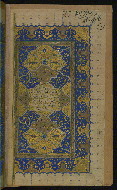
- Title: Double-page illuminated frontispiece
- Form: Incipit; frontispiece
- Label: This is the right side of a double-page illuminated frontispiece. This page begins the first poem.
fol. 2a:
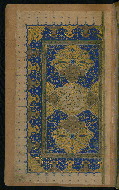
- Title: Double-page illuminated frontispiece
- Form: Incipit; frontispiece
- Label: This is the left side of a double-page illuminated frontispiece containing two small medallions. One gives the name of the illuminator as ʿAbd al-Wahhāb ibn ʿAbd al-Fattāḥ ibn ʿAlī.
fol. 17a:
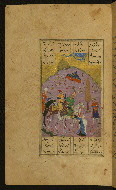
- Title: Sultan Sanjar and the old woman
- Form: Illustration
- Text: Makhzan al-asrār
- Label: An old woman petitions Sultan Sanjar about the questionable behavior of his policeman. The face of Sultan Sanjar was very clearly re-painted in India.
fol. 25a:
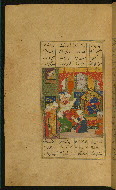
- Title: Two scholars quarreling
- Form: Illustration
- Text: Makhzan al-asrār
- Label: Two physicians are depicted quarreling in the presence of the king. The inscription over the doorway on the left reads: al-sulṭān al-ʿādil.
fol. 33b:
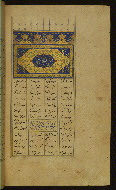
- Title: Incipit with illuminated titlepiece
- Form: Incipit; titlepiece
- Text: Khusraw va Shīrīn
- Label: This incipit page has an illuminated titlepiece introducing the second poem of the Khamsah, Khusraw va Shīrīn, which is written in white on a blue ground.
fol. 44b:
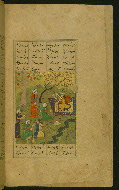
- Title: Shīrīn admiring the portrait of Khusraw
- Form: Illustration
- Text: Khusraw va Shīrīn
- Label: Shīrīn is depicted in the company of her maidens admiring the portrait of Khusraw.
fol. 49a:

- Title: Khusraw watching Shīrīn bathing
- Form: Illustration
- Text: Khusraw va Shīrīn
- Label: Shīrīn bathes in a fountain as Khusraw, drawn by her beauty, watches.
fol. 58a:

- Title: Khusraw fends off an attacking lion
- Form: Illustration
- Text: Khusraw va Shīrīn
- Label: Khusraw fends off an attacking lion.
fol. 78b:
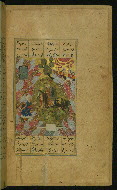
- Title: Shīrin on horseback watches Farhād
- Form: Illustration
- Text: Khusraw va Shīrīn
- Label: Shīrin, on horseback, watches Farhād digging a canal for a stream of milk.
fol. 88b:
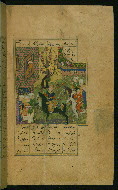
- Title: Khusraw arriving at Shīrīn's palace
- Form: Illustration
- Text: Khusraw va Shīrīn
- Label: Khusraw comes on horseback to visit Shīrīn, the Armenian princess.
fol. 106a:
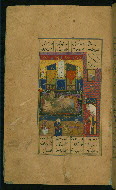
- Title: Khusraw and Shīrīn in their wedding chamber
- Form: Illustration
- Text: Khusraw va Shīrīn
- Label: This image of Khusraw and Shīrīn in their wedding chamber has been erased at some point in the manuscript's history. The inscription on the right reads: al-sulṭān al-ʿādil.
fol. 111b:
fol. 121b:
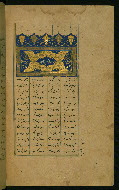
- Title: Incipit with illuminated titlepiece
- Form: Incipit; titlepiece
- Text: Laylá va Majnūn
- Label: This incipit page has a titlepiece introducing the third poem of the Khamsah, Laylá va Majnūn, which is written in white on a blue ground.
fol. 132b:
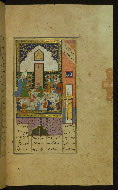
- Title: Laylá and Majnūn at school
- Form: Illustration
- Text: Laylá va Majnūn
- Label: Laylá and Majnūn are portrayed as small children at school, when they first met.
fol. 137a:
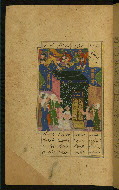
- Title: Majnūn and his father in front of the Kaʿbah in Mecca
- Form: Illustration
- Text: Laylá va Majnūn
- Label: Majnūn and his father, who is on the right, are depicted in front of the Kaʿbah in Mecca.
fol. 144b:
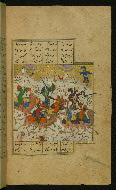
- Title: Nawfal fighting with Laylá’s tribe
- Form: Illustration
- Text: Laylá va Majnūn
- Label: Nawfal, a dedicated friend of Majnūn’s, fights with Laylá’s tribe.
fol. 149b:
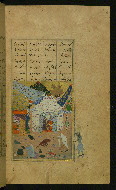
- Title: Majnūn, in chains, is led by the old woman to Laylá's tent
- Form: Illustration
- Text: Laylá va Majnūn
- Label: A shackled Majnūn is lead by an old woman in front of the encampment of Laylá’s tribe.
fol. 157b:

- Title: Majnūn playing with wild animals
- Form: Illustration
- Text: Laylá va Majnūn
- Label: In the wilderness, Majnūn is comforted by wild animals.
fol. 167a:
fol. 175b:
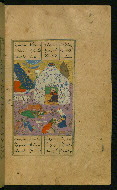
- Title: Laylá and Majnūn fainting at the sight of each other
- Form: Illustration
- Text: Laylá va Majnūn
fol. 185b:
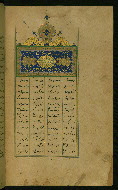
- Title: Incipit with illuminated titlepiece
- Form: Incipit; titlepiece
- Text: Haft paykar
- Label: This incipit page has a titlepiece introducing the fourth poem of the Khamsah, Haft paykar, which is written in white on a blue ground.
fol. 197a:
fol. 203a:
fol. 207b:
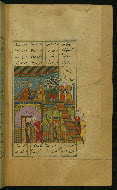
- Title: Fitnah carrying the ox upstairs to Bahrām Gūr
- Form: Illustration
- Text: Haft paykar
- Label: Fitnah is shown carrying the ox upstairs to Bahrām Gūr. The inscription over the gate to the garden reads: Allāhu wa-lā siwāhu.
fol. 213b:
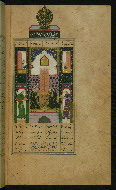
- Title: Bahrām Gūr in the black pavilion
- Form: Illustration
- Text: Haft paykar
- Label: Bahrām Gūr visits the princess in the black pavilion. The inscription on top reads: yā mufattiḥ al-abwāb yā musabbib al-asbāb.
fol. 221a:
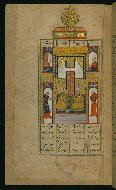
- Title: Bahrām Gūr in the yellow pavilion
- Form: Illustration
- Text: Haft paykar
- Label: Bahrām Gūr visits the princess in the yellow pavilion. The inscriptions read: al-sulṭān al-aʿẓam al-khāqān al-aʿdal.
fol. 224b:
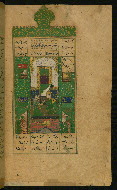
- Title: Bahrām Gūr in the green pavilion
- Form: Illustration
- Text: Haft paykar
- Label: Bahrām Gūr visits the princess in the green pavilion.
fol. 227bisb:
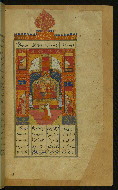
- Title: Bahrām Gūr in the red pavilion
- Form: Illustration
- Text: Haft paykar
- Label: Bahrām Gūr visits the princess in the red pavilion.
fol. 232a:
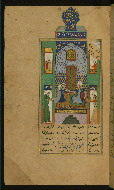
- Title: Bahrām Gūr in the blue pavilion
- Form: Illustration
- Text: Haft paykar
- Label: Bahrām Gūr visits the princess in the blue pavilion.
fol. 238b:
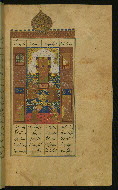
- Title: Bahrām Gūr in the sandalwood pavilion
- Form: Illustration
- Text: Haft paykar
- Label: Bahrām Gūr visits the princess in the sandalwood pavilion.
fol. 243b:
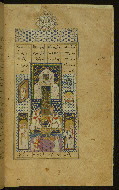
- Title: Bahrām Gūr in the white pavilion
- Form: Illustration
- Text: Haft paykar
- Label: Bahrām Gūr visits the princess in the white pavilion.
fol. 250a:
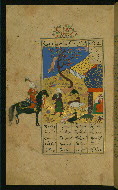
- Title: Bahrām Gūr meeting a shepherd who hung his dog on a tree
- Form: Illustration
- Text: Haft paykar
fol. 257b:
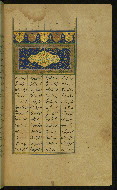
- Title: Incipit with illuminated titlepiece
- Form: Incipit; titlepiece
- Text: Iskandarnāmah
- Label: This incipit page has a titlepiece introducing the fifth poem of the Khamsah, Iskandarnāmah, which is written in white on a blue ground.
fol. 276b:
fol. 291a:
fol. 305b:
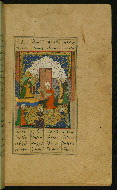
- Title: Alexander the Great admiring his portrait ordered by Nūshābah
- Form: Illustration
- Text: Iskandarnāmah
fol. 320a:
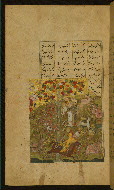
- Title: Alexander the Great hunting deer
- Form: Illustration
- Text: Iskandarnāmah
- Label: The figure of Alexander the Great (Iskandar), who is depicted hunting deer, is smudged.
fol. 338b:
fol. 351b:
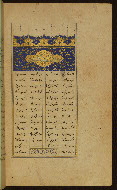
- Title: Incipit with illuminated titlepiece
- Form: Incipit; titlepiece
- Text: Iqbālnāmah
- Label: This incipit page has a titlepiece introducing the Iqbālnāmah, the second part of the fifth poem of the Khamsah, Iskandarnāmah, which is written in white on a blue ground.
fol. 364a:
fol. 372a:
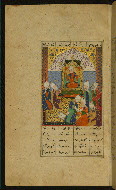
- Title: Alexander the Great and the seven philosophers, including Aristotle, Socrates, and Plato
- Form: Illustration
- Text: Iqbālnāmah
fol. 387b:
The binding is original.
Brown leather with stamped center and side panels brushed with gold (no flap); inscription in upper and lower rectangles; doublures with blue dentelle-style filigree work
Seal impression: Muḥammad Asharf ibn Muḥammad Khātam al-Ḥusaynī, 1173 AH / 1759-60 CE (fols. 1a and 401a)
Ownership statement: Ḥusayn […?], 1308 AH / 1890-1 CE (fol. 1b)
Walters Art Museum, 1931, by Henry Walters bequest
Gacek, Adam. Persian Manuscripts in the Libraries of McGill University: Brief Union Catalogue. (Montreal: McGill University Libraries, 2005), no. 111.
Storey, C. A. Persian Literature: A Bio-Bibliographical Survey, Vol. 2. (London: Luzac, 1927- ), 438-495.
Principal cataloger: Gacek, Adam
Catalogers: Landau, Amy; Smith, Sita
Editor: Bockrath, Diane
Conservators: Jewell, Stephanie; Quandt, Abigail
Contributors: Barrera, Christina; Emery, Doug; Herbert, Lynley; Noel, William; Simpson, Shreve; Tabritha, Ariel; Toth, Michael B.; Valle, Chiara
The Walters Art Museum
Licensed for use under Creative Commons Attribution-NonCommercial-ShareAlike 3.0 Unported Access Rights, http://creativecommons.org/licenses/by-nc-sa/3.0/legalcode. It is requested that copies of any published articles based on the information in this data set be sent to the curator of manuscripts, The Walters Art Museum, 600 North Charles Street, Baltimore MD 21201.
